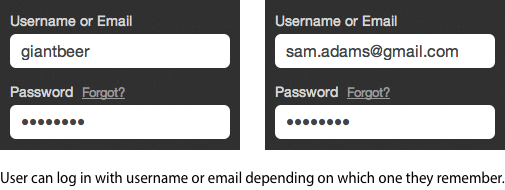A Flexible ID Field Helps Forgetful Users Log In
veryone forgets things from time to time. But forgetting a username on a website can keep users locked out of their account. It’s like forgetting your keys and getting locked out of your house. Getting locked out is a frustrating experience in life and online as well.
Luckily, there’s a way you can help users who forget their usernames log in to their account. Most users remember their email address more than the usernames they use across different websites. This is because most users check their email regularly and are more familiar with their email address. However, some sites don’t allow users to log in with their email, but rather username only. This can force forgetful users to create a new account all over again. Users are not only frustrated that they forgot their username, but now they have to do extra work. In addition to the frustration, forcing forgetful users to create a new account can populate your database with ghost accounts. This isn’t good for you or the user.

A flexible identification field would allow users to enter either their email address or username to log in. This not only helps users who forget their username, but also users who forget which email address they used to sign up for your site. A user might forget the email address they used, but remember the username. The flexible ID field adapts to the user and what they remember. Users have the freedom to choose to log in with their username or email. If one fails, they can always try the other option.
Adding a flexible ID field on your login form has many benefits. A username and email address are both unique to a user. It makes sense to allow them to choose what they want to use to log in if they forget one or the other. Limiting the user to only one login ID runs the risk of users forgetting it and getting locked out of their account. Getting locked out isn’t fun for anyone. But with a flexible ID field, you can prevent this from happening to your users. Giving users the help they need when they make errors is important part of interface design. But preventing users from making those errors in the first place is a more important part of interface design that designers should strive for
veryone forgets things from time to time. But forgetting a username on a website can keep users locked out of their account. It’s like forgetting your keys and getting locked out of your house. Getting locked out is a frustrating experience in life and online as well.
Luckily, there’s a way you can help users who forget their usernames log in to their account. Most users remember their email address more than the usernames they use across different websites. This is because most users check their email regularly and are more familiar with their email address. However, some sites don’t allow users to log in with their email, but rather username only. This can force forgetful users to create a new account all over again. Users are not only frustrated that they forgot their username, but now they have to do extra work. In addition to the frustration, forcing forgetful users to create a new account can populate your database with ghost accounts. This isn’t good for you or the user.

A flexible identification field would allow users to enter either their email address or username to log in. This not only helps users who forget their username, but also users who forget which email address they used to sign up for your site. A user might forget the email address they used, but remember the username. The flexible ID field adapts to the user and what they remember. Users have the freedom to choose to log in with their username or email. If one fails, they can always try the other option.
Adding a flexible ID field on your login form has many benefits. A username and email address are both unique to a user. It makes sense to allow them to choose what they want to use to log in if they forget one or the other. Limiting the user to only one login ID runs the risk of users forgetting it and getting locked out of their account. Getting locked out isn’t fun for anyone. But with a flexible ID field, you can prevent this from happening to your users. Giving users the help they need when they make errors is important part of interface design. But preventing users from making those errors in the first place is a more important part of interface design that designers should strive for
No comments:
Post a Comment